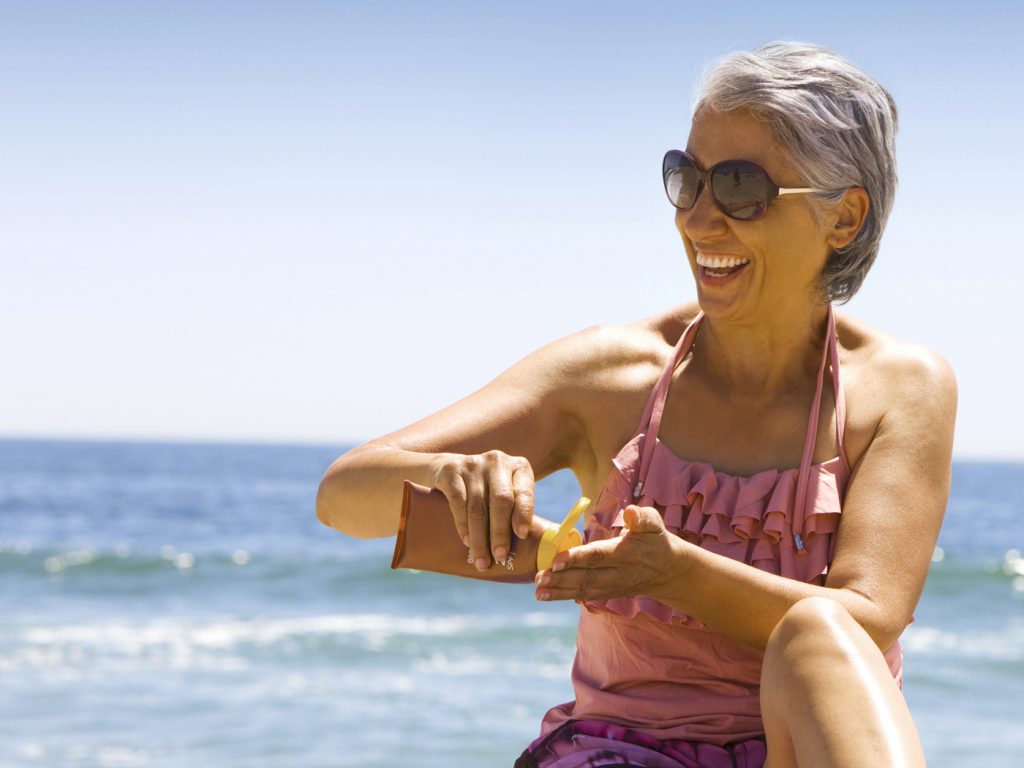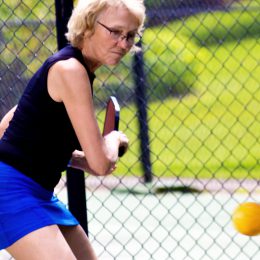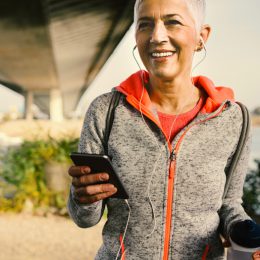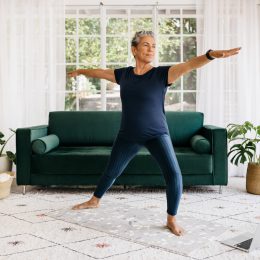7 Ways to Stay Cool and Avoid Heat Stroke This Summer
Your body’s ability to handle heat changes with age. Here’s what every older adult should know to stay safe and comfortable outdoors.

As the temperature rises, so does your motivation to spend more time outdoors. But before you know it, the dog days of summer arrive, with temps that can quickly cause a host of heat-related illnesses in older adults.
“As we age, our bodies are no longer able to adjust to sudden changes in temperature as well as they could when we were younger,” explains Angela Catic, M.D., assistant professor and director of the geriatric medicine fellowship at Baylor College of Medicine.
But simply getting older isn’t the only risk factor. Heat is also especially dangerous for people with chronic conditions like heart disease, diabetes, or thyroid disorders, as well as those taking certain medications, like beta-blockers or antihistamines, that can make it harder for your body to self-regulate its temperature by reducing your sweating impulse.
Any of these things can make you more vulnerable to heat-related illnesses, including the most serious of all: heat stroke.
What Exactly Is Heat Stroke?
Heat stroke occurs when your body overheats due to prolonged exposure or high activity in hot temperatures, says Luke Belval, M.S., C.S.C.S., director of research at the University of Connecticut Korey Stringer Institute.
It can cause symptoms like nausea, vomiting, lightheadedness, or dizziness, he says. But that’s also true for many other heat-related illnesses, like heat exhaustion or heat stress. To identify heat stroke, medical pros look for two key things:
- A core body temperature of 104˚ Fahrenheit or higher.
- Something called “central nervous system dysfunction,” or a change in mood or behavior. For example, a normally quiet person may suddenly become loud and boisterous, Belval says.
Full-blown heat stroke is a medical emergency that requires prompt care, since you may need IV fluids, monitored cooling, or a continual observation of your vital signs, Dr. Catic says. If untreated, heat stroke can cause serious damage to your organs, and can even be deadly. That’s why it’s so important to know how to spot the signs of heat stroke and get medical attention right away.
Equally important: taking steps to prevent heat stroke from happening in the first place. Here are seven ways to do that.
1. Plan Your Workouts Around the Weather
If the forecast shows a few hot days coming up (a heat index of 91˚F or higher is the danger zone), take a look at your workout schedule—you might want to switch things up, Belval says.
For instance, you may want to move your regular long, hilly interval walking workout indoors, or sub in your easy, moderate-paced walk around the neighborhood instead.
Even if you don’t have an intense outdoor workout planned for a hot day, you still may want to truncate your exercise plan to be safe, Belval says. A good rule of thumb: Scale back anywhere from 10 to 20 percent, both in intensity and duration.
And if you are doing intervals, make sure to lengthen the amount of time you spend in your recovery or rest phases, rather than your work phases. You’ll still get an effective workout, with less risk of overheating.
Other cool ideas to stay fit this summer: Hop in the pool, take a new fitness class, try a total-body gym machine workout, or check out this exercise ball routine.
2. Weigh Yourself Before and After Outdoor Activity—and Drink the Difference
Hot weather can be dehydrating, which can make you sweat less.
“If your sweat rate goes down, your body can’t cool itself as much,” Belval says. As a result, it’s harder for your body to maintain its normal core temperature. It’s always important to stay hydrated—but especially when exercising or spending an extended amount of time in the heat.
Your move: Weigh yourself before and after outdoor activity, and “aim to drink 125 to 150 percent of your losses in ounces,” Belval says. So if you weigh in two pounds, or 32 ounces, lighter after your sweat session, aim to drink 40 to 48 ounces of water within two to three hours. “You don’t want to guzzle it all right away—your stomach can only absorb so much at a time,” Belval says.
One note: If you have certain health conditions where your fluid intake is restricted—like congestive heart failure—check with your doctor about how to adjust your hydration status in the heat.
3. Limit Cocktails and Caffeine
Staying hydrated is crucial, but not just any drink will do.
“It may sound tempting, but a cold beer or glass of sangria might not be the best choice at your outdoor block party or family barbecue,” Dr. Catic says. That’s because alcohol can have diuretic effects, which can leave you dehydrated. The same is true for caffeinated beverages, liked iced coffees or many iced teas, she says.
Stick with water as your main source of hydration. You can supplement it with a glass of 100 percent fruit juice, lemonade, or herbal iced tea if you need a flavor boost. Just choose options with low or no added sugar as much as possible.
As far as water, the exact amount you need depends on the foods you’re eating, how much you exercise, and any medication instructions from your doctor. Don’t wait until you’re thirsty—that’s a sign you’re already slightly dehydrated. Other warnings: headache, fatigue, yellow urine, and these five lesser-known signs that you’re low on H20.
4. Stock a Cooler Full of Gym Towels
Put that extra cooler in your basement to good use by turning it into a cooldown station. “Simply fill up the cooler with ice and water,” Belval says, “then put a few small towels in there, and let them get cold.”
Subscribe to our newsletter
It's quick and easy. You could be one of the 13 million people who are eligible.
Already a member? Click to discover our 15,000+ participating locations.
Follow Us
If you feel yourself getting overheated, swing by the cooler, remove a few towels, and pack them over as much exposed skin as possible, he says. Let them sit for two to three minutes, then put them back in the cooler to get cold again.
This can help reduce the rise in body temperature that can occur when you’re in the heat. It’s especially helpful if you’re traveling to a warm climate from a cold one or living in an area that has experienced an early heat wave since your body hasn’t had a chance to get used to the higher temperatures.
5. Slather on the SPF
It’s not only the best antiaging product out there, but sunscreen also helps guard against heat stroke.
“When our skin is sunburned, that can impact our body’s ability to cool itself,” Dr. Catic says. “It makes your skin less able to perspire, and less able to protect you from the sun and heat, so you’re going to warm up more quickly.”
Before you head outdoors—whether for exercise, errands, or leisure—apply water-resistant, broad-spectrum sunscreen with a minimum SPF of 30, according to the American Academy of Dermatology. Don’t forget to apply it to your neck, chest, and any other exposed skin.
6. Embrace the Summer Siesta
A hot day’s going to be a scorcher no matter what, but the most brutal heat tends to occur in the midday hours, Dr. Catic says.
She recommends the majority of your outdoor time—especially if you’ll be exercising—be in the early morning or evening hours. Avoid peak heat times, which generally occurs between 11 a.m. and 4 p.m.
Not sure what to do with yourself during that indoor time? Take a tip from people who live in traditionally hotter climates: Schedule an afternoon siesta during the summer months.
“It gets them inside, they cool off in the middle of the day, they get some rest, and then they go on about their activities,” Dr. Catic says. Just be sure to keep your afternoon snooze brief—ideally 10 to 30 minutes. Indulging in a longer nap can make it harder to fall asleep at night. Power naps, on the other hand, not only help you feel sharper, but they may improve your sleep quality.
7. If You’ve Recently Been Sick, Take Extra Precaution
If you’ve been battling a summer cold or flu, be extra careful about getting back into the heat, Belval says. “Even if you’re free of symptoms, your body temperature can still be elevated for a period of time after,” he says.
If your temperature is still a bit elevated, that means it’ll take less to raise it to dangerous levels. So you want to be extra cautious about too much heat exposure: Take frequent breaks indoors, stay out of direct sunlight, and make sure to sip on something cool. And don’t forget to pack that cooler of ice-cold towels!




